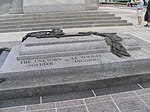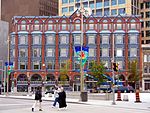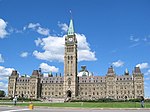Confederation Square

Confederation Square (French: Place de la Confédération) is an urban square in Ottawa, Ontario, Canada, and is considered the second most important ceremonial centre in Canada's capital city, after Parliament Hill. Roughly triangular in area, with Canada's National War Memorial at its centre and the Valiants Memorial at its periphery, the square is bounded by Wellington Street to the north and branches of Elgin Street to the east and west. The square was designated a National Historic Site of Canada in 1984. Confederation Square's importance is due not only to its central location in Ottawa and its status as a rare Canadian example of a City Beautiful-inspired square, but also arises from the landmark buildings that frame the square: the Château Laurier, the Senate of Canada Building, the National Arts Centre, the Central Chambers, the Scottish Ontario Chambers, the Central Post Office, the PMO and the East Block. Part of the square crosses over the Rideau Canal, itself a National Historic Site of Canada and a World Heritage Site.
Excerpt from the Wikipedia article Confederation Square (License: CC BY-SA 3.0, Authors, Images).Confederation Square
Wellington Street, (Old) Ottawa Centretown
Geographical coordinates (GPS) Address Nearby Places Show on map
Geographical coordinates (GPS)
| Latitude | Longitude |
|---|---|
| N 45.42402 ° | E -75.69551 ° |
Address
Wellington Street
K1P 1C7 (Old) Ottawa, Centretown
Ontario, Canada
Open on Google Maps







